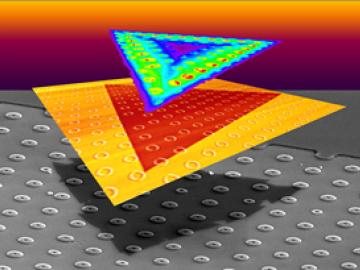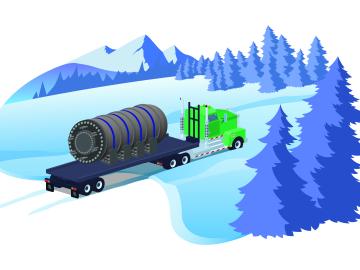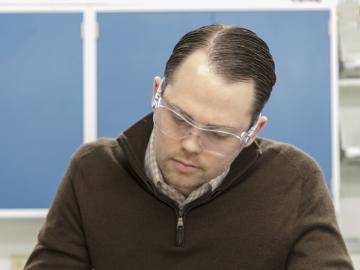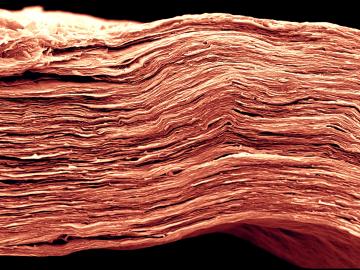
Filter News
Area of Research
- Advanced Manufacturing (6)
- Biology and Environment (15)
- Building Technologies (3)
- Computational Engineering (1)
- Computer Science (7)
- Electricity and Smart Grid (1)
- Energy Science (80)
- Fuel Cycle Science and Technology (1)
- Fusion and Fission (14)
- Fusion Energy (8)
- Isotope Development and Production (2)
- Isotopes (3)
- Materials (69)
- Materials Characterization (1)
- Materials for Computing (13)
- Materials Under Extremes (1)
- National Security (13)
- Neutron Science (18)
- Nuclear Science and Technology (18)
- Nuclear Systems Modeling, Simulation and Validation (2)
- Quantum information Science (1)
- Sensors and Controls (2)
- Supercomputing (21)
- Transportation Systems (1)
News Type
News Topics
- (-) Advanced Reactors (25)
- (-) Buildings (36)
- (-) Grid (38)
- (-) Irradiation (2)
- (-) Machine Learning (27)
- (-) Materials Science (90)
- (-) Nuclear Energy (47)
- (-) Polymers (23)
- (-) Security (13)
- 3-D Printing/Advanced Manufacturing (83)
- Artificial Intelligence (51)
- Big Data (25)
- Bioenergy (42)
- Biology (47)
- Biomedical (28)
- Biotechnology (14)
- Chemical Sciences (48)
- Clean Water (16)
- Composites (23)
- Computer Science (105)
- Coronavirus (28)
- Critical Materials (23)
- Cybersecurity (20)
- Education (3)
- Element Discovery (1)
- Emergency (1)
- Energy Storage (75)
- Environment (86)
- Exascale Computing (14)
- Fossil Energy (2)
- Frontier (17)
- Fusion (27)
- High-Performance Computing (44)
- Hydropower (6)
- Isotopes (25)
- ITER (5)
- Materials (96)
- Mathematics (3)
- Mercury (5)
- Microelectronics (1)
- Microscopy (28)
- Molten Salt (8)
- Nanotechnology (41)
- National Security (21)
- Neutron Science (81)
- Partnerships (33)
- Physics (30)
- Quantum Computing (18)
- Quantum Science (43)
- Simulation (19)
- Space Exploration (13)
- Statistics (2)
- Summit (30)
- Transportation (62)
Media Contacts

Scientists have discovered a way to alter heat transport in thermoelectric materials, a finding that may ultimately improve energy efficiency as the materials

A team led by scientists at the Department of Energy’s Oak Ridge National Laboratory explored how atomically thin two-dimensional (2D) crystals can grow over 3D objects and how the curvature of those objects can stretch and strain the

OAK RIDGE, Tenn., May 7, 2019—Energy Secretary Rick Perry, Congressman Chuck Fleischmann and lab officials today broke ground on a multipurpose research facility that will provide state-of-the-art laboratory space

In a step toward advancing small modular nuclear reactor designs, scientists at Oak Ridge National Laboratory have run reactor simulations on ORNL supercomputer Summit with greater-than-expected computational efficiency.

Scientists at Oak Ridge National Laboratory have developed a low-cost, printed, flexible sensor that can wrap around power cables to precisely monitor electrical loads from household appliances to support grid operations.

Oak Ridge National Laboratory scientists are evaluating paths for licensing remotely operated microreactors, which could provide clean energy sources to hard-to-reach communities, such as isolated areas in Alaska.

Oak Ridge National Laboratory is using ultrasonic additive manufacturing to embed highly accurate fiber optic sensors in heat- and radiation-resistant materials, allowing for real-time monitoring that could lead to greater insights and safer reactors.


OAK RIDGE, Tenn., March 1, 2019—ReactWell, LLC, has licensed a novel waste-to-fuel technology from the Department of Energy’s Oak Ridge National Laboratory to improve energy conversion methods for cleaner, more efficient oil and gas, chemical and

Gleaning valuable data from social platforms such as Twitter—particularly to map out critical location information during emergencies— has become more effective and efficient thanks to Oak Ridge National Laboratory.


